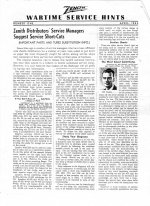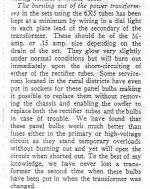Hello All:
Having some trouble isolating a problem with one of
the 5ar4 rectifiers in the Dynaco mkIII.
Noticed one day no sound coming from one mono block- let's say the
"Left". Checked the fuse- Blown. Replaced with 3A slow-blow and noticed
rectifier not lighting. All other tubes fine. Tried tube in "Right" amp- didn't light. Figured bad rectifier.
Purchased new pair JJ 5ar4s, put the working old 5ar4 from "Right" amp in the Left (just in case)- again didn't light.
Took voltage tests at rectifier socket with rectifier in and out, all other tubes in. (120V mains)
Results:
Rect In: Got 430V at pins 4&6 which is on spec in/manual
reading 5.4 at pin#8 and 28.+ at pin#2
"Bad" rectifier- lit up (Nat Union Tube)
W/O rectifier: 439.7V at pins 4&6
5.4V at pin#2 and 4.2V at pin#8
Tried to put "Left" amp back in system, w/orig rectifier back in
since it wasn't(?) having issues under testing.
BUT: arced- blue flash, shut it off. Fuse o.k.
Wondering what my next steps should be? Appreciate any input.
Much Thanks.
Mark
Having some trouble isolating a problem with one of
the 5ar4 rectifiers in the Dynaco mkIII.
Noticed one day no sound coming from one mono block- let's say the
"Left". Checked the fuse- Blown. Replaced with 3A slow-blow and noticed
rectifier not lighting. All other tubes fine. Tried tube in "Right" amp- didn't light. Figured bad rectifier.
Purchased new pair JJ 5ar4s, put the working old 5ar4 from "Right" amp in the Left (just in case)- again didn't light.
Took voltage tests at rectifier socket with rectifier in and out, all other tubes in. (120V mains)
Results:
Rect In: Got 430V at pins 4&6 which is on spec in/manual
reading 5.4 at pin#8 and 28.+ at pin#2
"Bad" rectifier- lit up (Nat Union Tube)
W/O rectifier: 439.7V at pins 4&6
5.4V at pin#2 and 4.2V at pin#8
Tried to put "Left" amp back in system, w/orig rectifier back in
since it wasn't(?) having issues under testing.
BUT: arced- blue flash, shut it off. Fuse o.k.
Wondering what my next steps should be? Appreciate any input.
Much Thanks.
Mark
It might be a good reason for the fuse to blow.
I would start with removing the GZ34 and connect an external DC source to the B+ chain and see if it draws any current ( it should not if amp is "off"). Then turn on the amp
and see how much current it uses, any overcurrent must be fixed ( broken bias circutry, bias ,6550 tubes etc) If amp seems to work , leave it on while poking with a woodstick and listen for noices from speaker. If it still works, leave on for some hours and repeat test.
When amp works ok, remove DC source, install a NEW GZ34 and turn on.
I would start with removing the GZ34 and connect an external DC source to the B+ chain and see if it draws any current ( it should not if amp is "off"). Then turn on the amp
and see how much current it uses, any overcurrent must be fixed ( broken bias circutry, bias ,6550 tubes etc) If amp seems to work , leave it on while poking with a woodstick and listen for noices from speaker. If it still works, leave on for some hours and repeat test.
When amp works ok, remove DC source, install a NEW GZ34 and turn on.
Are the capacitors that filter the B+ the correct value?
Or, did someone "improve" the amplifier by increasing the first capacitor after the rectifier with a much higher capacitance?
Or, did someone "improve" the amplifier by increasing the first capacitor after the rectifier with a much higher capacitance?
Had a fair number of JJ GZ34 arcing over. Switched to Sovtek and had no more problems.
The underlying problem might be with the amp, I just wanted to point out that arcing in a new production JJ GZ34 could be unrelated to your problem and might lead to wrong conclusions.
Rundmaus
The underlying problem might be with the amp, I just wanted to point out that arcing in a new production JJ GZ34 could be unrelated to your problem and might lead to wrong conclusions.
Rundmaus
I haven't found *any* current GZ34's worth peeing on. Vintage amplifiers with modern AC line voltages are really serious duty, even if some "guru" hasn't made things worse (all too common).
If afraid to stray above the 2 Amp filament draw of the originals, type 5R4 can be used reliably. B+ voltage will soar at turn-on, but it does with the original GZ34's too. A Varistor in the filament supply helps a little. If not afraid, there's a world of 3 Amp filament rectifiers, all plug and play.
All good fortune,
Chris
If afraid to stray above the 2 Amp filament draw of the originals, type 5R4 can be used reliably. B+ voltage will soar at turn-on, but it does with the original GZ34's too. A Varistor in the filament supply helps a little. If not afraid, there's a world of 3 Amp filament rectifiers, all plug and play.
All good fortune,
Chris
The tendency of modern 5AR4 to arc and self-destruct can be prevented by placing a 1N4007 or similar diode in series with each plate lead.
The tendency of modern 5AR4 to arc and self-destruct can be prevented by placing a 1N4007 or similar diode in series with each plate lead.
I've never understood the reasoning behind this, although I have done it (twice). How does the silicon rectifier know when to be the working rectifier, saving the day, and when not to, adding extra ringing to the power transformer's secondary windings? Why keep the 5AR4?
Call me a skeptic, but willing to be woke.
All good fortune,
Chris
They're wired in series, so when reverse biased the 1N4007 provides 1kV of blocking, preventing the 5AR4 from arcing.
When forward biased, the 1N4007 just adds a fraction of a volt drop. The 5AR4 has a substantial forward drop,
which is designed into the original circuit. Also the tube rectifier has controlled warm up for a soft start.
When forward biased, the 1N4007 just adds a fraction of a volt drop. The 5AR4 has a substantial forward drop,
which is designed into the original circuit. Also the tube rectifier has controlled warm up for a soft start.
Last edited:
I understand what it's claimed to do, but it looks like a lot of tinsel to me. Am I missing something significant?
All good fortune,
Chris
All good fortune,
Chris
Back in "the old days", silicon rectifiers were not invented yet.
Selenium rectifiers did not have the size/capacity to be used in equipment.
So......
Now, since a 3 "tiny" amp silicon rectifier (1N5408) can be added in as "insurance" on most equipment, it's a wise thing to do.
Selenium rectifiers did not have the size/capacity to be used in equipment.
So......
Now, since a 3 "tiny" amp silicon rectifier (1N5408) can be added in as "insurance" on most equipment, it's a wise thing to do.
Yup, it prevents 5AR4s from arcing on a cold start which usually results in a cathode to plate short, and from failing on hot starts and transients.
I have had vintage 5AR4s fail from the above causes (although rarely) as well as modern ones.
You exaggerate slightly 😀, two diodes isn't exactly a lot of tinsel and reduces the likelihood of rectifier failures.
I have had vintage 5AR4s fail from the above causes (although rarely) as well as modern ones.
You exaggerate slightly 😀, two diodes isn't exactly a lot of tinsel and reduces the likelihood of rectifier failures.
My old 1963 RCA Victor console stereo still has its originally installed (date code 1962) 5AS4A rectifier in it.
Still pumping out that B+ without a problem.
Still pumping out that B+ without a problem.
Sounds like a shorted or failing input filter capacitor, what's the service history on the amp was it recapped?
You exaggerate slightly 😀, two diodes isn't exactly a lot of tinsel and reduces the likelihood of rectifier failures.
Oh, I believe that it works. No doubt. But I'm unconvinced that the often heard arguments (maintains the advantages of both, etc.) are anywhere real. As a kludge that allows the factory rectifier to keep glowing and the amplifier to keep working without major power supply rework, works a treat.
But I doubt if anybody would include this arrangement in a fresh design. I see it as a cosmetically acceptable solution to a very difficult problem when restoring vintage amplifiers, to be honored as such, but no more. Power supplies are, of course, usually the number one problem for these old parties in the cruel modern world. A can of D5 fixes numbers two three and four, Lord willin'.
All the best fortune,
Chris
Back during WW2, when manufacturers were stuggling, and replacement parts were scarce, Zenith Radio had a reasonable "preventative fix" for saving transformers, rectifiers and radios.
I enlarged the last paragraph - read it.
This goes along with the "modern" style of backing up tube rectifiers with silicon diodes.
So, in effect, it's nothing new, just cheap insurance against catastrophic failures.
I enlarged the last paragraph - read it.
This goes along with the "modern" style of backing up tube rectifiers with silicon diodes.
So, in effect, it's nothing new, just cheap insurance against catastrophic failures.
Attachments
Last edited:
- Home
- Amplifiers
- Tubes / Valves
- Bad Rectifier Dyna MKIII?

